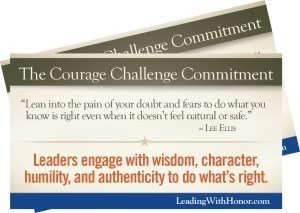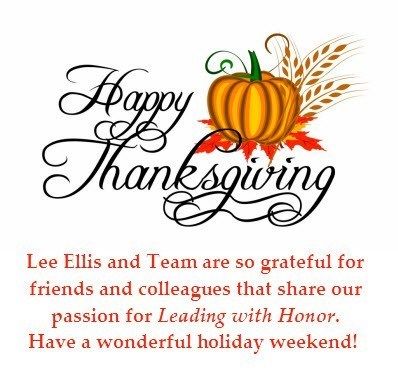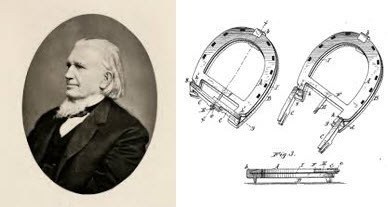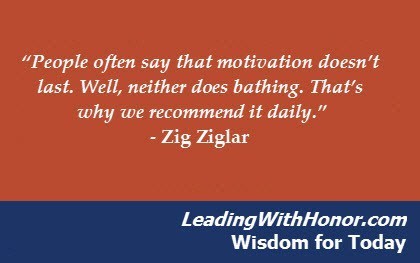Lee Ellis's Blog, page 321
November 27, 2014
Happy Thanksgiving from Lee Ellis and Team
November 26, 2014
Grateful for Honorable Leaders and Organizations – Read Inside
 Special thanks for these generous comments from Jerry Hendrix and Robert Stevenson, executive leaders at Mohawk Flooring, regarding Lee and Leading with Honor -
Special thanks for these generous comments from Jerry Hendrix and Robert Stevenson, executive leaders at Mohawk Flooring, regarding Lee and Leading with Honor -
“When faced with immense adversity, Lee Ellis turned what could have been devastating into an opportunity. In his book ‘Leading with Honor,’ he details a unique approach to leadership shaped by his experience in a Vietnamese POW camp. These decisive strategies are just as relevant to aspiring leaders as they are to seasoned professionals who have held leadership roles for many years. By focusing on honor and what that means each and every day, readers from all backgrounds will be compelled to live better and lead stronger.”
Organizations like Mohawk are making great strides in leading their organizations the right way—with character, courage, and competence in their industry. If you have a story how Leading with Honor has helped your personal or organizational leadership, please share it with us—we’d love to hear from you. So grateful and thankful for our blog-reading friends this week!

November 24, 2014
How Leaders Can Show Apprecation During the Holidays
 There are so many opportunities during the holiday season to show gratefulness and appreciation as a leader. One of the best ways to focus on healthy engagement with all those you come in contact with on a daily basis. Time is the greatest asset that you can give others.
There are so many opportunities during the holiday season to show gratefulness and appreciation as a leader. One of the best ways to focus on healthy engagement with all those you come in contact with on a daily basis. Time is the greatest asset that you can give others.
Learn the art and science of healthy engagement by taking The Courage Challenge! This complimentary tool is a great way share your best as a leader.
Click here to get started. Already using the Courage Challenge in your leadership? Please share it in this post.

November 23, 2014
On This Day in Leadership History, November 23, 2014
On this day in history in 1835, Henry Burden patented the horseshoe manufacturing machine, a creative invention that provided a practical solution. Leaders do this type of work everyday—finding creative ways to provides solutions to challenges and obstacles.
Leaders—keep your mind open to new creative solutions as you work and lead!


November 22, 2014
A Frequently Asked Question from Lee Ellis – “What are some of the hardest and most rewarding parts about leading?”
 A Frequently Asked Question from Lee Ellis – “What are some of the hardest parts about leading? As well as the most rewarding?”
A Frequently Asked Question from Lee Ellis – “What are some of the hardest parts about leading? As well as the most rewarding?”
Answer: “I think I have a pretty clear picture about a lot of the issues of leadership. I haven’t seen a lot change in the last 20 or 30 years. A leader is always walking a tight rope. A leader should always feel a tension between mission and people, between results and relationships. There is a tension of feeling like you are being pulled to one side by your mission/goals and then by your people on the other side. That is where the rubber meets the road. You have to be able to work both sides of the coin. By nature, very few people are wired to do both. You are wired toward results by #personality or toward #relationships by personality. You have to get results to stay in business and accomplish the mission. You also have to take care of the people because if you don’t, you won’t have results. They are the ones doing a lot of the work and the ones fighting a lot of the battles. You have to figure out how to support them and keep their morale up, energized and inspired even in difficult times.
Your integrity and character are a big part of that. Then there is the balance between mission and people, relationship and results. Beyond that, it is sharpening the saw both technically, professionally and from a #leadership standpoint your continuing to learn and grow. In its simplest form that’s what leadership is all about. It is about having the character so that people can trust you. You have to ride that fine line and when you need results. You may need to go to the team and say I love you, but we have to work on Saturday. Other times you have to go to the boss and say I can’t push my people any harder. We have been pushing full scale and I have to give them some slack. That takes courage.”
Do you have a question for Lee? Ask in the comments section below.


November 21, 2014
Leading with Honor Wisdom for Today, November 21, 2014
“People often say that motivation doesn’t last. Well, neither does bathing. That’s why we recommend it daily.” – Zig Ziglar


November 20, 2014
Lee Ellis Responds to “How Important is a Support Team in Life and Work? in This Video Clip
In this short clip, Lee shares the wisdom of having a support team in life and leadership work. Why is it important, and what’s the criteria? Watch below and please share your comments!


November 19, 2014
The Latest Recommendation from Lee’s Bookshelf – “The Advantage” by Patrick Lenconi
 The Latest recommendation from Lee’s bookshelf is The Advantage by Patrick Lenconi.
The Latest recommendation from Lee’s bookshelf is The Advantage by Patrick Lenconi.
Here’s a quick summary – “There is a competitive advantage out there, arguably more powerful than any other. Is it superior strategy? Patrick Lencioni argues that the seminal difference between successful companies and mediocre ones has little to do with what they know and how smart they are and more to do with how healthy they are. This book provides leaders with a groundbreaking, approachable model for achieving organizational health–one that maximizes human potential and aligns the organization around a common set of principles.”
Learn more about this book! If you’ve read it, please share your thoughts – thank you


November 18, 2014
Fill in the Blank – “One of the qualities that I’m most thankful for in my team…”
Fill in the Blank – “One of the qualities that I’m most thankful for in my team at work, school, club, or church is ________________.”
Please share your comments and answers by posting the comments section – thanks for sharing!


Four Fundamentals to Build a Culture of Trust in Your Organization
By Lee Ellis
In Patrick Lencioni’s latest book The Advantage, he points out that in today’s competitive world a healthy organization is likely to be the greatest competitive advantage you can have. He’s right, so what exactly does that look like? Well, let’s take a closer look at the culture of an unhealthy organization. To outsiders like Pat and me, three strong indicators are –
A lack of trust leading to poor teamwork and alignment.
A lack of communication clarity about mission, vision, and values.
A fear of conflict. People are not allowed to say what they really think.
With these symptoms, you can predict a lack of accountability on team goals which results in sloppy execution, inadequate results, and ultimately, a poor reputation in your industry.
However you want to assess and execute the best results and have a great place to work (they typically go together), so let’s consider the four fundamentals that can achieve both goals.
Build Trust
Trust is the hallmark of cohesive teams. Without it, people have doubts, fears, and uncertainty making alignment and unity impossible. Remember that we’re not talking about baseline trust such as “Do I trust you not to steal my wallet?” Trust in this context means that I understand and accept you because you’re willing to be vulnerable and genuine, I have an awareness of each team member’s natural behavior strengths and struggles, communication style, and more. Because we know each other really well, there are no hidden agendas and you won’t take advantage of me if I’m not at the meeting with the boss. This kind of trust takes time, and leaders must go first with this virtue.
Clarify and Over-Communicate
Leading a business means facing many crucial issues and decisions every day, but a good leader has the ability to synthesize large amounts of information into something simple.
Too often leaders assume that their staff see and understand what they do, and this causes many problems with execution. Imagine the quarterback having a complex play in mind, yet he only calls a short version of it in the huddle. Ten teammates must execute precisely to make the next play a success; but if they don’t have the same picture as the quarterback, mistakes will likely result in a setback. It’s the same in business. Leaders have to continually clarify and over-communicate the message all the way to the bottom of the organization to make sure the team understands what plays the leader is calling. This is an important element of balancing getting results with cultivating good work relationships.
Create a Safe Environment and Encourage Debate
In healthy organizations there’s an absence of fear, and courage is rewarded.
Do your people have to walk on eggshells, or do they feel safe with you? Can they disagree with you and have a fair hearing, or do your reactions equate disagreement with disloyalty? Healthy leaders invite creative conflict prior to making key decisions to get team buy in and to make sure that other reasonable ideas are evaluated. They’re more interested in being effective than being “right.” One of the greatest desires of all people is to be understood, so show courage by listening and learning from your people. Your courage, vulnerability, and authenticity will be seen as strengths.
Be Courageous
Leading isn’t easy. Every day you face tough issues, and your people are watching to see if you will walk the talk of your stated values. It will take all the courage you have and the support of your team and confidants to consistently lead with honor.Lean into the pain of your fears to do what you know is right, and you will send a message of healthy courage throughout your organization.
Remember that positive emotions are contagious and powerful, and leaders go first.
LE
*Would you like to assess your team’s cohesion and leadership potential? Watch Lee’s brief message about his vision for Leadership Behavior DNA, a new set of services to help organizations fulfill their mission and goals.










